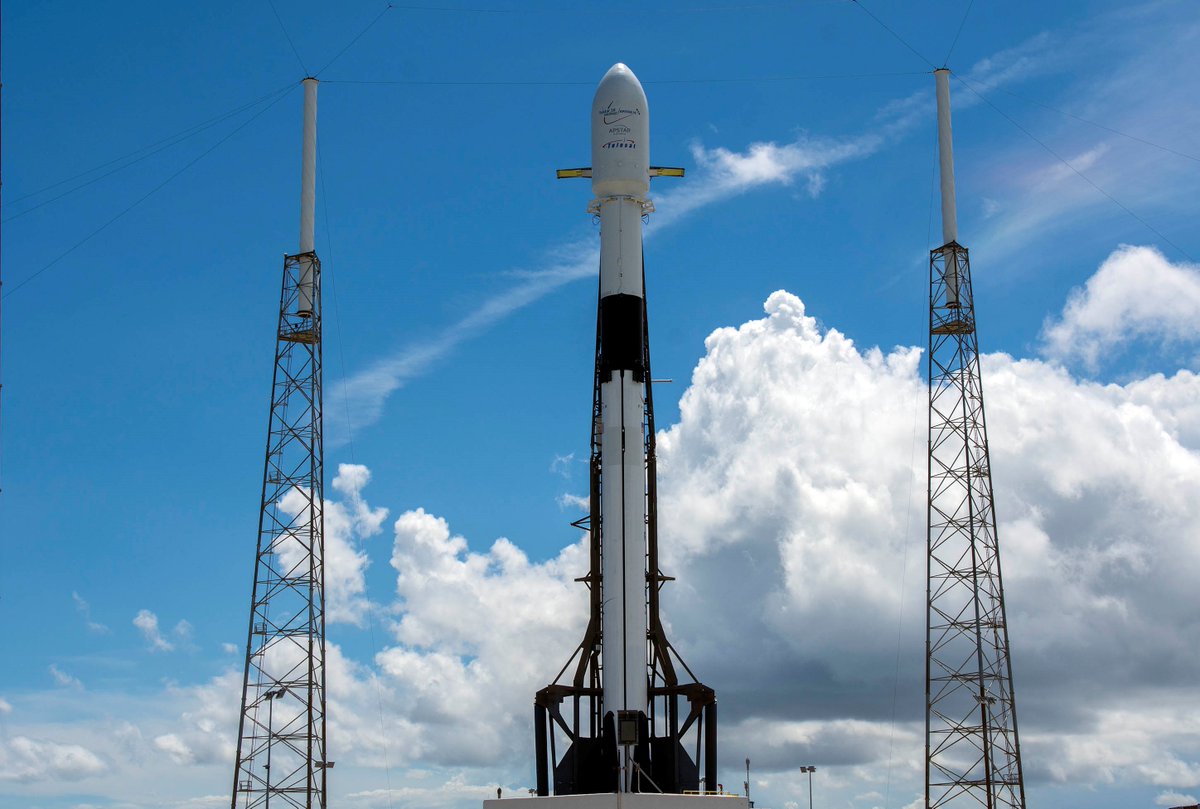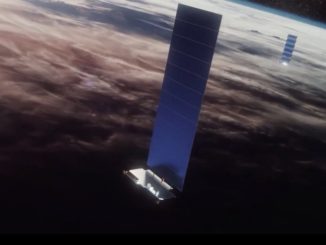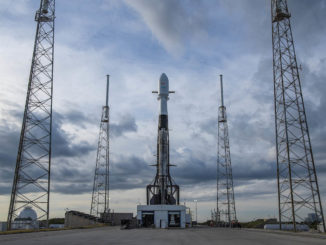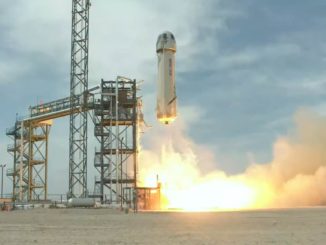
The Federal Communications Commission has granted a request by SpaceX to begin launching spacecraft for the company’s Starlink broadband network to a lower orbit than originally planned, overruling protests by competitors and clearing a major regulatory hurdle before the launch of the first batch of Internet satellites from Cape Canaveral in May.
The regulatory commission approved SpaceX’s proposal Friday to fly more than 1,500 of its Starlink satellites at an altitude of 341 miles, or 550 kilometers, instead of the 714-mile-high (1,150-kilometer) orbit originally planned.
“This approval underscores the FCC’s confidence in SpaceX’s plans to deploy its next-generation satellite constellation and connect people around the world with reliable and affordable broadband service,” said Gwynne Shotwell, SpaceX’s president and chief operating officer. “Starlink production is well underway, and the first group of satellites have already arrived at the launch site for processing.”
The Starlink satellites will launch aboard a SpaceX Falcon 9 rocket from Cape Canaveral’s Complex 40 launch pad as soon as mid-May. The Starlink mission is next in line on SpaceX’s launch manifest at the Florida spaceport after the liftoff of a Dragon supply ship for the International Space Station, a launch currently scheduled for no earlier than Friday.
It typically takes SpaceX a couple of weeks to prepare for another flight from the same launch pad.

SpaceX, led by billionaire businessman Elon Musk, has not said how many Starlink satellites it will launch on the Falcon 9 rocket. Company officials have also not disclosed information about each spacecraft’s dimensions or mass.
The Starlink satellites are built and manufactured at a SpaceX facility in Redmond, Washington.
The Falcon 9 rocket will heard northeast from Cape Canaveral, aiming for a deployment altitude somewhat lower than the satellites’ 341-mile-high operating orbit.
The FCC also granted SpaceX authority last week to use six ground stations to test the communications payloads on the first set of Starlink satellites, beginning as they maneuver from their launcher separation orbit to their final operating altitude.
With the FCC approvals last week, the first segment of SpaceX’s multi-tiered Starlink satellite fleet will include 1,584 spacecraft arranged in 24 orbital planes inclined 53 degrees to the equator.
The first two Starlink pathfinder satellites launched last year to prove out SpaceX’s antenna design and electric propulsion system, which will be used for orbital adjustments and maintenance during each spacecraft’s operating life.
“This experiment demonstrated the performance of SpaceX-built technology, such as its phased-array antennas and its powerful Hall-effect thruster propulsion system,” SpaceX wrote in last year’s application to the FCC to modify its Starlink license for the lower altitude.
The satellites, named Microsat 2A and 2B, launched as piggyback payloads on a Falcon 9 rocket from California with the Spanish Paz radar observation satellite in February 2018.
“These experimental satellites also provided key operational lessons, such as the benefits of operating at different altitudes and practical experience coordinating with and avoiding neighboring orbital objects,” the application read. “Even as operations continue with these two experimental satellites, SpaceX is already poised to leverage this successful demonstration to take the next step in its satellite development.”
“SpaceX will use elements from the Microsat spacecraft as the foundation of an efficient and economic architecture that will enable the rapid acceleration of deployment of the overall constellation,” SpaceX wrote to the FCC.
SpaceX received an initial green light from the FCC for its planned Starlink network in March 2018. At that time, regulators approved SpaceX’s proposal for a Starlink constellation consisting of 4,425 satellites transmitting in Ku-band and Ka-band frequencies in orbits more than 700 miles above Earth.
The FCC in November granted approval for SpaceX to operate a follow-on network of 7,518 additional Starlink satellites in a lower 210-mile-high (340-kilometer) orbits transmitting in V-band frequencies.
The Starlink fleet will use laser inter-satellite links to hand off Internet connections around the world without routing the signals through a ground station.
Days before the second FCC approval, SpaceX filed an application to modify the license issued the previous March. The company proposed shifting 1,584 of the Starlink satellites originally originally slated to fly at the 714-mile-high altitude to a lower 341-mile-high orbit.
Friday’s ruling from the FCC formally approved that change to SpaceX’s license.
In its request to modify the license last year, SpaceX officials said the lower operating altitude for the first batch of Starlink satellites would help assuage space debris concerns. If a Starlink relay station in the lower orbit fails, atmospheric drag will bring the satellite back to Earth within about five years, and most of the spacecraft will burn up during re-entry.
Matt Desch, CEO of Iridium and an advocate for policy solutions to address the problem of growing space debris, tweeted in November that he was pleased with SpaceX’s proposal to fly the first Block of Starlink satellites in a lower orbit.
“Premature failures at the higher altitude would have (meant the satellites) stayed up there 1000+ years being debris creators,” Desch tweeted. He added that SpaceX’s decision to first populate the lower orbit was “very responsible.”
Iridium operates one of the largest fleets of commercial satellites currently in orbit, with 75 one-ton voice and data relay spacecraft flying 485 miles (780 kilometers) above Earth.
SpaceX also argued that the lower orbit allows for greater separation between the Starlink fleet and large “mega-constellations” planned by OneWeb, Telesat and others. Having the satellites positioned closer to Earth also provides users with broadband connectivity with reduced latency, or time delay, and the spacecraft’s user beams will be finer, decreasing the network’s spectrum requirements.
There are tradeoffs to the lower orbit. More Starlink satellites will be needed to cover the same geographic area, and the spacecraft will have to fight against the effects of atmospheric drag.
Despite the reduced coverage offered by the lower orbit, SpaceX has redesigned its network architecture to reduce the total number of Ku-band and Ka-band Starlink satellites from 4,425 to 4,409.
The first set of Starlink satellites will transmit signals solely in Ku-band frequencies, allowing SpaceX to accelerate deployment of the network while continuing to develop dual Ku-band and Ka-band antenna technology, SpaceX officials said.
Earlier this year, SpaceX submitted an application up to 1 million user terminals for customers to connect to the Starlink network.
Starlink’s biggest near-term competitor is OneWeb, backed by the Japanese firm SoftBank, Virgin Group, Airbus, Coca-Cola, Intelsat, the Mexican conglomerate Grupos Salinas, and other investors.
OneWeb launched its first six broadband satellites in February on a Russian-made Soyuz rocket from French Guiana.
The first phase of OneWeb’s fleet will number 648 satellites to fly into orbit on Soyuz rockets from Kazakhstan, Russia and French Guiana under the auspices of a multi-launch contract with Arianespace. OneWeb built a new satellite factory at Exploration Park near the Kennedy Space Center in Florida to produce the refrigerator-sized spacecraft in an assembly line fashion.
Telesat is planning a smaller network of broadband satellites in low Earth orbit. The Telesat LEO fleet will initially include 117 satellites, but could grow to hundreds more.
The first tech demo satellite for Telesat’s broadband project launched on an Indian rocket in January 2018. Earlier this year, Telesat selected Blue Origin’s New Glenn rocket, set to debut in 2021, to deliver many of the constellation’s satellites to orbit on multiple launches.
Blue Origin is owned by Jeff Bezos, the founder of Amazon, which is also designing a constellation of more than 3,000 broadband satellites under a project codenamed Kuiper.
The scale of the Starlink project is immense.
SpaceX estimates it will cost $10 billion to develop and launch thousands of Starlink satellites using its Falcon rocket family, design and deploy user terminals, and build out the infrastructure needed to connect a global network.
The company was founded in 2002 on Musk’s fortune, and has made a steady business of launching satellites and cargo for commercial customers, NASA and the U.S. military.
But like development of SpaceX next-generation Starship super-heavy-lift transport craft, the Starlink fleet is a new endeavor for SpaceX, requiring an infusion of funding as the company builds out a massive satellite production plant and tackles the development of ground terminals, a challenge that often paces the schedule of new satellite communications programs. SpaceX is looking for external investments to help prop up development of the Starlink network.
The fundraising has included venture capital investments and a $250 million high-yield loan negotiated last year. Google and Fidelity Investments funneled $1 billion into SpaceX in 2015 for a combined stake of nearly 10 percent in the company.
The Wall Street Journal reported earlier this month that SpaceX recently closed a $500 million fundraising round with a valuation of more than $30 billion. The newspaper reported SpaceX has promptly launched another fundraising campaign to try to secure $500 million more for the cash-hungry Starlink project.
Email the author.
Follow Stephen Clark on Twitter: @StephenClark1.



